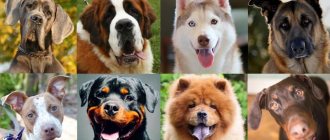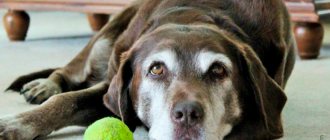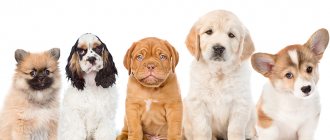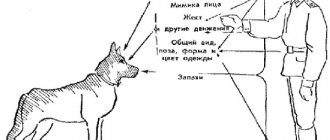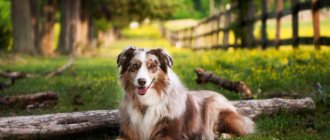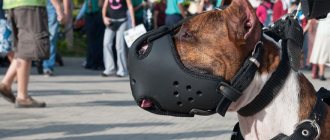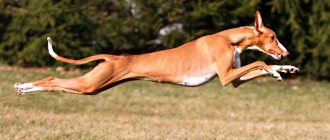photo taken from Zooclub.ru
You will forever remember the day when a puppy first appears in your home. Being its owner is not as easy as it might seem at first glance. Improper care of an animal and lack of time to raise it leads to the pet turning not into a reliable companion, but into a heavy burden that you want to get rid of as soon as possible. Before you take on such responsibility, understand that the appearance of a dog in the house will radically change the life of your family.
We’ll tell you in our article which dog breed is best to choose for a private house or apartment, for a family or for novice dog breeders, depending on your character and lifestyle, and how not to make a mistake with your choice and what characteristics to correctly navigate.
What is a dog for?
Why do you need me?
In order to choose the right puppy and subsequently not regret your decision, first of all, you need to sincerely answer the question: “Why do I need a dog?” Depending on the breed, dogs can serve as guards, watchmen, hunters, companions, or simply loyal friends. Perhaps all your life you have dreamed of walks in the fresh air with a Siberian husky, or you prefer an evening on the couch with a miniature toy terrier by your side, or maybe you want to spend time like a king in the company of a Welsh Corgi? Some owners are crazy about long-haired breeds, with which they can experiment with hairstyles and buy them fun accessories, while other owners prefer short-haired animals that they don’t have to vacuum every day. Before getting a dog, carefully weigh the pros and cons. Make sure that your family members support this idea and that the psychological climate in the house is quite calm. Read articles about the care and maintenance of dogs and evaluate your strengths.
If the decision to adopt a puppy has been made, and it is unshakable, you need to decide why you need a dog, and, accordingly, what breed, gender and category of pets to consider.
Dogs of any breed are divided into 3 classes.
- Pet. Translated from English, pet means “domestic animal.” As the name suggests, this category includes simple dogs “for the home.” They cannot be shown and are not suitable for breeding due to any deviation from the breed standard. Such animals are castrated or sterilized so that the defect is not passed on to the offspring. But non-standard does not mean bad, a puppy of the pet category can grow up to be a beautiful, smart dog and become your devoted friend. Pet class puppies are cheaper than others.
- Breed. Breed is translated as “breed”. Breed-class dogs have a good pedigree, they meet the breed standard, but with minor features. They participate in exhibitions where they do not claim to win. Their main task is to produce offspring in which the genes of outstanding ancestors can manifest themselves. Breed category puppies are significantly more expensive than pet ones.
- Show. The word show does not need translation. Show class puppies are the best of the best. Experts know these pets by name, and at exhibitions they have no equal. Often you have to reserve a champion puppy even before its birth. Show class is the most expensive category of dogs.
What gender of dog is best to get?
Having decided on the choice of breed, you need to decide what gender your pet will be, female or male? It is believed that a bitch is more emotionally close to a person. She:
• more flexible and attached to the owners; • easier to train and educate; • is attracted to the opposite sex only twice a year; • if you have the appropriate permission, it can be used in breeding and will delight you with adorable puppies.
The disadvantages of keeping a female dog are, first of all, estrus and the danger of unplanned pregnancies, as well as complications associated with false pregnancy. The dog will need either neutering or, if the female is being bred, increased attention and care during her heat period and the next 2 months thereafter.
If you want to receive joyful emotions every day from your pet’s love of life and recklessness, then choose a male dog. He: • is more active; • there is no surprise in the appearance of puppies; • more consistent with breed standards; • may participate in exhibitions and other social events without restrictions.
The disadvantages of “boys” can be considered a constant interest in the opposite sex, as well as a tougher character, a more pronounced desire to dominate in the “pack”, which your family will become for him. Males are not as flexible as females, but the results of their training are often more impressive.
Golden retriever
The Golden Retriever is almost the most popular breed in the world, and all thanks to their friendly disposition, devotion to the owner, complete lack of desire to run away, and pedigree advertising.
At the same time, the retriever is a beautiful, active and understanding dog that treats each family member with respect, regardless of age.
Goldens have long hair, but it is easier to vacuum it up than short hair, like that of a boxer, for example. It is unpretentious in nutrition and needs sufficient physical activity, because... By nature, the Golden Retriever is an active dog, so in order to avoid chaos in the house, it is advisable to allow the dog to frolic in nature.
The Labrador is not suitable for protection, but is good at hunting and communicating with children. Easy to train.
Suitable for: everyone without exception, gets along well with other animals.
8
Choosing a dog breed
Many people first of all try to choose a breed of animal based on the principle - beautiful, funny, popular, fashionable, inexpensive, and so on. This is the main mistake. Before choosing a dog, you need to evaluate and find out a lot of questions for yourself.
Initially, you need to determine the puppy’s fundamental purpose in the future. It is clear that we are talking about a devoted friend and family member. However, all breeds have their own characteristics. There are dogs that love to run. And keeping them constantly in an enclosure or cramped apartment is truly sadism.
Dogs for beginners should not be fighting breeds. The consequences can be unpredictable and very cruel. There is a lot of information in the press about how large dogs attacked people and even children. The reason is the owner’s lack of experience in training and poor upbringing of the pet.
Boy or girl
After choosing a dog breed, future owners think about what gender of puppy is best to get. In this matter, we recommend focusing on personal sympathies, however, males and females have differences in appearance and behavior that are worth keeping in mind.
Pros and cons of male dogs:
- males are more suitable for participation in sports competitions;
- more powerful and larger than females;
- lazier in matters of training;
- Males have a stronger sex drive. His needs will have to be compensated with long-term physical activity;
- During a walk, the male is active and strives for his fellow tribesmen. If there is a bitch in heat nearby, you will have to hold him tightly on a leash.
Pros and cons of females:
- more domestic and affectionate, more attached to the owner;
- less aggressive and pugnacious;
- sleeker and smaller in size;
- more obedient and easier to train;
- Bitches come into heat 2 times a year. They become nervous, disobedient, and the risk of infections increases. During these periods, the dog needs to be protected from male dogs and monitored especially carefully, because it may try to escape.
In general, it can be noted that the distinguishing feature of males is independence, and that of females is tractability. But a lot depends on the temperament of a particular dog.
Choosing the gender of the dog
In order to choose the gender of your future pet, you need to know some of their features.
Features of males:
- — males are more suitable for participation in competitions;
- - they are physically more developed;
- - it is more difficult to train them, since they are lazy;
- - They have a very strong attraction to the opposite sex. To compensate for this, it is necessary to heavily load the animal with exercises and walks.
Features of bitches:
- - females are more attached to the owner than males, and they are also more affectionate;
- - they have less aggression;
- - look more elegant due to their smaller size;
- — it is easier to train them, since they obey the owner;
- - presence of heat twice during the year. During this period, females become capricious and nervous. In addition, at this time she must be protected from males.
IMPORTANT! Do not forget that each character trait also depends on the temperament of each individual individual.
Beagle
The dogs, according to legend, accompanied the knights of King Arthur and are called “singing”, thanks to their ringing, drawn-out bark. And also, a prototype of the famous cartoon dog Snoopy.
A non-aggressive, smart dog that gets along well with children and other pets.
To this day, beagles retain their hunting instinct, which periodically manifests itself in a sudden desire to dig up the ground or chase a cat. Therefore, the beagle needs daily physical activity, preferably hunting. If this is not possible, let the dog run freely around the nearby park. You need to walk at least three times a day.
Beagles are prone to obesity, and the importance of walks increases several times, because... With an inactive lifestyle, there is a risk of limb deformation due to excess weight.
But before that, be sure to give the dog some training, in particular, learn the command “near!” and “come to me!” Otherwise, there is a risk of losing your pet.
But beagles are difficult to train, so from the first day it is important to show who is boss.
Suitable for: children, hunters. Needs a lot of physical activity, walking at least three times a day.
5
How to find a good nursery
So, if you have already decided which breed and gender of puppy is right for you, it’s time to look for a reliable breeder. There is no need to rush when it comes to buying a dog. The animal will live with you for about 15 years, so it is so important to choose the right puppy. Refrain from spontaneous purchases at the poultry market or through free message boards on the Internet. At a minimum, the puppy may not meet the breed standard when it grows up, and at the maximum, there is a risk of buying a sick animal that will have to be treated for a long, expensive and unsuccessful time.
The best place to buy a puppy is a specialized nursery. You can choose a pet together with an experienced dog breeder or on your own, following your heart. As a rule, nurseries have their own websites, and you can find customer reviews about them.
Lifehack: go to a dog show of the breed you dream of. There, see which dogs you like best, meet their owners and find out where they got their puppies. Usually dog lovers are happy to share this information and also give valuable advice. Representatives of leading nurseries also actively participate in exhibition events and will not forget to provide you with business cards.
The number of kennels depends on the popularity of the breed and the region. Having chosen a trustworthy option, call them and make an appointment. During the conversation, ask the breeder about the conditions in which the puppy is kept and its parents. If you have the feeling that they are trying with all their might to urgently sell the puppy, this should alert you. A good breeder will ask you a lot of questions about your family, living conditions, free time and even hobbies to make sure that the puppy will be in good hands and will suit your personality.
For those who are not afraid of difficulties
Experienced dog breeders, for whom raising a dog is perceived as a difficult but exciting task, can consider (if the conditions necessary for keeping large, restive dogs are available) such breeds as Akita Inu, Wolfhound, Alaskan Malamute, Australian Cattle Dog, Rhodesian Ridgeback, Bullmastiff , pitbull . But any breed of dog with a strong character will require enormous patience, endurance and desire from the owner to take care of the pet almost constantly.
Text:
How to choose a healthy puppy
It's time to go to the nursery for your future pet. Please note that puppies must be in a clean room that does not have a strong unpleasant odor. Often the breeder begins to show all his diplomas and lists the show titles of the puppy's parents. Listen to this information, but don't let your guard down. In addition to potential championship credentials, it is very important what character the dog will have.
If you have the opportunity to meet the puppy's parents, don't miss it. This way you can evaluate their behavior personally. If you can't arrange a meeting, ask the breeder if they were aggressive, pugnacious or cowardly. These qualities are inherited, as is the desire to howl, tear up furniture and bark for no reason. Look at photographs of the puppy's grandparents, if available.
You should avoid purchasing a sick puppy immediately. However, many diseases are not obvious or may only appear in the future. Try to “talk” to the breeder; he may accidentally mention points that may indirectly indicate the puppy’s illnesses:
- a test for hip dysplasia in giant breed breeders is mandatory; its absence is suspicious;
- if the puppy does not eat well, he may have gastrointestinal or liver diseases;
- dogs with allergies often give birth to puppies with the same problem;
- If an animal is terrified of fireworks, thunderstorms and other loud sounds, then its nervous system is unstable. Hysterical parents are unlikely to give birth to a brave and balanced puppy;
- dogs running away during walks are unwanted producers of offspring;
- In pursuit of profit, unscrupulous breeders may breed dogs with epilepsy, which cannot be noticed until there is a seizure.
A healthy puppy will be active and friendly. If you kneel down and call him, he will come to you. The baby will show curiosity about new people and toys. He should look happy, frolic with his brothers and sisters. In the breeder's arms, the puppy is calm, allows itself to be petted, and normally perceives touches on its paws and face. Avoid buying cowardly and intimidated pets, as well as aggressive and dominant individuals. With age, a dog's character will not change significantly.
10 main external signs of a healthy puppy:
- clear, lively look;
- there is no pus or other discharge in the eyes;
- moist and shiny nose;
- correct bite, the number of teeth corresponds to the standard;
- the ears are pink and clean;
- there are no sores, pimples and, especially, parasites on the skin;
- shiny, silky coat;
- tail without strong creases or docked;
- lymph nodes are not enlarged;
- not a bloated tummy.
A big plus in favor of the breeder will be his agreement to enter into a written contract for the purchase and sale of the puppy. If significant defects specified in the contract are identified, the animal can be returned. In addition, the very presence of “insurance” will discourage the seller from selling a problem pet.
Who should I choose? You are all so cute!
Tips for choosing
Choosing a puppy from the litter
It is best to choose a puppy in person. It will take about 20-30 minutes to decide. This time is enough to select the puppy you like. Such a criterion as the personal sympathy of the future owner is the main thing in this matter. If the breeder is located far away, it is best to select a puppy via video call; you may not understand anything from the photo.
When buying a puppy, focus on its physical activity. If the puppy is not sleeping, then he should always be doing something, because they are extremely inquisitive. Usually the puppy that runs up to the stranger first, that is, to the future owner, is taken away. They also say how a puppy chooses its owner.
If a two-month-old puppy is aggressive, it is worth thinking about the instability of his nervous system. This is manifested by anxiety when strangers appear, non-participation in general games, and also by the fact that he hides. Perhaps this puppy has a problem, perhaps he is mentally unstable.
How to choose a healthy puppy
The main thing in choosing a puppy is that he is completely healthy. This can be determined by its appearance. The coat should be clean, shiny, and free of dandruff. It smells specific, there is the smell of milk. There should be no peeling, spots or bald patches on the skin. The claws should be clean, beautiful, without cracks, the ears should also be free of all kinds of wounds and sores. The whites of the eyes should be clean and white. The nose should be wet. If the nose is running or there are crusts on it, this indicates certain diseases.
The puppy's teeth are ideally sharp and white, the gums are pink and not swollen. There should be no bad breath. The puppy's movements should be relaxed, maybe a little awkward. The puppy's weight must be within the standards for its age and breed. The joints should not be enlarged. The ribs should be palpable. If there are nodules on them, we can talk about the initial stage of rickets.
NOTE! Almost every breed has inherent hereditary diseases. To exclude sick dogs from offspring, genetic tests are performed and X-rays are taken to check for the presence of dysplasia.
Compliance with the standard in appearance
When choosing a purebred dog puppy, you need to understand that such dogs have their own special character, special care and the constant need for an appropriate appearance. It is possible that the puppy will not have documents, but if it meets the standard, we can talk about its purebred origin.
For about two months, correctly set ears, bite, coat color, pigmentation of the nose, claws and some other signs must meet the standard.
The question of choosing a puppy to participate in exhibitions remains open. After all, the standard characterizes an adult dog, but a puppy does not always correspond to this. If you do not have experience in this matter, you need to seek the help of an expert dog handler.
Puppies with pedigree
The pedigree confirms the puppy's birthright, but is not a guarantee of its quality. Parents' titles don't affect anything here either. When choosing a dog for hunting, sport or protection, the main characteristics are the characteristics of the parents and the diplomas confirming this.
In the case of breeding dogs with pedigrees without the approval of the club, the puppies will not be given documents, and this will greatly reduce their price. In addition, this will increase the opportunity to get puppies from close relatives.
The difference between a purebred puppy and a simple one is the presence or absence of metrics. The metric records the main data about the puppy, which, when it reaches six months, is transferred to the pedigree. All puppies from the same litter are given nicknames starting with the same letter. Sometimes this is convenient for those who cannot decide on a name. But usually, owners name their dogs whatever they want and the puppy gets two names. If you are not going to take part in exhibitions and breed puppies, you do not need to exchange the metric for a pedigree.
REFERENCE! The difference between a pedigree and a metric is that it contains information about ancestors up to the third generation.
Age for a puppy to move into your home
The best age for moving a puppy to a new home is 2-2.5 months. At this time, the puppies are almost completely independent, do not depend much on their mother, and already eat solid food. Then they will cope well with the move and quickly get used to their new place of residence.
Review of breeds by criteria
There is no point in arguing about the best breed; different pets will be ideal for each dog breeder. But you can make a list of the most popular animals suitable for apartments.
For allergy sufferers
People who suffer from allergies to the fur or smell of dogs should not give up their true friends. There are a number of pets that do not shed and do not cause allergic reactions . You can choose either a large breed or a small one.
Bichon Frize
A type of lapdog with curly, springy coat of pure white color. This is a small, playful dog with a high level of intelligence, easy to train, and capable of performing tricks of any complexity. The breed can often be found in the circus arena or in street show programs. Bichon height is 23-29 cm, weight is 4-7 kg . Dogs are considered decorative, they are the strongest of this group, and therefore are suitable for families with children. The average price is 25-50 thousand rubles .
Schnauzers
Miniature Schnauzer A group of dogs that includes 3 breeds that differ in size and typical colors: Miniature Schnauzer, Miniature Schnauzer and Giant Schnauzer. Difficult animals with a strong independent character. Bred for service in law enforcement agencies, they have a strong protective instinct. Recently they have been used as decorative. The size can be in three variations: 30-35 cm, 44-50 cm, 60-70 cm . The average price is 20-70 thousand rubles .
Miniature Schnauzer
Giant Schnauzer
Bedlington Terrier
A pet that looks like a lamb due to its curly short hair and the unusual shape of its muzzle (the bridge of the nose is arched). Considered one of the most flexible terriers, suitable for calm families. At the withers it can reach 41 cm, and weighs from 8-10 kg. The average price is 40-50 thousand rubles .
Dogs without smell
There are a number of breeds with a certain set of characteristics that eliminate their unpleasant odor. These include hairless dogs, pets with long or short hair, but without undercoat, and Poodle variations are included in a separate group.
Poodle
A breed with 4 height varieties, 2 coat types and about 5 main colors. Animals with one of the highest intelligence among dogs. Pets learn quickly and cope with circus programs, although they were originally bred for aquatic hunting. They are calm in nature, practically do not bark, small representatives do not particularly need physical activity, although they are active by nature. Height: 24-28 cm, 28-35 cm, 35-45 cm, 45-60 cm . Regardless of size, the Poodle is suitable for apartment living. The average price is 10-70 thousand rubles .
Mexican hairless dog
This is an open and sociable pet that will not shed or emit odors. Gets along easily among other animals, is friendly and active. Suitable for keeping in an apartment, does not require frequent walks and easily tolerates separation from the owner, despite the affection. The breed is bred in three height variations: 25-35 cm, 36-45 cm, 46-60 cm . Price – 8-150 thousand rubles . Similar dogs are the Peruvian Hairless Terrier and the American Hairless Terrier.
West Highland White Terrier
The cheeky dog, despite its size, becomes an ideal hunter and watchman. Its coat has no undercoat, which eliminates the unpleasant odor. The pet is a fidget, suitable for active families. He gets along with children, but does not like bullying and will not tolerate mischief. At the withers they reach 28 cm and weigh no more than 9 kg . Price: 15-35 thousand rubles .
Brussels Griffon
The Brussels Griffon and related similar breeds (for example, the Yorkshire Terrier) do not shed because they do not have an undercoat. For the same reason, they do not emit unpleasant odors. These are miniature decorative dogs with an easy-going character and interesting appearance. They are difficult to care for due to their long, coarse fur. Height – 26-32 cm, weight – 3-6 kg. The average price is 10-30 thousand rubles .
The cleverest
Researchers have identified 3 aspects by which dogs' intellectual abilities are assessed:
- Instinctive - the animal copes well with the functions for which it was bred (type of genetic intelligence);
- Adaptive – the pet can make decisions independently;
- Worker – good learning ability, quick reaction to new commands.
In general, the list of the smartest dogs is long; about 80 breeds have passed the test. But not every one of them will be a good apartment pet. When choosing a pet, you should pay attention not only to its size, but also to its independence. Animals with high intellectual abilities can be wayward and try to dominate the family.
Papillon
This is the smartest decorative dog, not counting Poodles. In addition to their cute appearance, pets have extraordinary training abilities. They are flexible and kind, but can become uncontrollable and like to manipulate people. Such an animal needs mental stimulation and good upbringing . Height – 28 cm, weight – 1.5-5 kg. Price – 12-80 thousand rubles .
Doberman
The Doberman is a large working dog, popular in European countries. Suitable for apartment living, but requires comprehensive training. Genetic functionality - defense and attack; for families with children it is better to choose a different breed. Intellectual abilities allow the Doberman to be trained as the owner needs. Height – 63-72 cm, weight – 40-45 cm. Average price – 10-40 thousand rubles .
Breeds that don't bark
In urban high-rise buildings, it is very important that the dog does not disturb the neighbors. In this case, breeds that cannot or do not like to bark are best suited.
Basenji
This is one of the most mysterious breeds, it is the only one that cannot bark at all. Dogs also rarely whine. The native dog, one of the most ancient, was found in central Africa. In addition to the fact that the animal is silent, it is also hypoallergenic, does not emit odors and does not shed. The pet can be wayward, but easily gets along in the apartment. Height – 40-43 cm, weight – 9-10 kg. Price – 10-25 thousand rubles .
Shar Pei
The Shar Pei is one of the most recognizable dogs, characterized by thick folds of skin distributed throughout the body. Animals really do not like to bark for no reason, only during play or to warn of danger. The pets are not too big: 44-51 cm at the withers , so they easily get along in apartment conditions. The average price is 10-50 thousand rubles .
For beginner dog breeders
Owning any pet is a big responsibility, so the whole family must make the decision. It is worth understanding that a dog is not a toy; it cannot be put on the shelf when it gets boring. This is a living creature that requires attention, education and care. For the first time, it is better to choose an unpretentious breed with a soft, easy-going character.
Pug
Pugs are funny, plump dogs that are rarely overly active. They are genetically programmed to be phlegmatic and sedentary. They do not need long and frequent walks; on the contrary, they get tired of them. Dogs easily get along with other pets and children and do not require special hygienic care or training. Suitable even for pensioners. Height – 28-32 cm, weight – 6-8 kg . Price – 15-30 thousand rubles .
Bernese Mountain Dog
Despite its impressive size, it is an almost ideal family dog. They can get along in any area, are quite lazy and unpretentious in maintenance, although they need long walks to maintain physical health. Herding dogs easily cope with the role of nannies for children and get along with other dogs. Height – 60-70 cm, weight – 36-50 kg. Price – 10-40 thousand rubles .
Apartment security guards and watchmen
Even the smallest pet can be endowed with a strong protective instinct. Therefore, it does not matter whether the dog is large or small, its guarding abilities do not depend on this.
Boxer
One of the best options for a guard dog can be considered a boxer. These animals have all the necessary qualities of a watchman, but are non-aggressive and love children. They are medium in size - 53-63 cm at the withers, short-haired (do not require careful grooming). But such pets need physical activity. The average price for Boxers is 15-30 rubles .
Amstaff or Staffbull
Amstaff Amstaff or Staffbull are two related fighting breeds that are ideal for apartment living. The animals are medium-sized (38-48 cm at the withers) , moderately aggressive, wary of strangers, but affectionate and kind to household members. They usually get along well with children. They require special education, training and physical activity. The average price is 15-60 thousand rubles .
Staffbull
Boston Terrier
This is a dog similar in appearance to the French Bulldog, which is justified by its common roots. The breed is classified as a small molossoid, which is where good guarding abilities come from. The pets are not large - only 38 cm at the withers . They are hardy and brave, suitable for active people. The average price is 10-35 thousand rubles .
Small apartment dogs
Of course, small decorative dogs that do not require active walks and intensive training are best suited for an apartment. They can even be trained to use a litter box at home, but you should not deprive the animals of the joy of fun walks.
Jack Russell Terrier
The breed became popular after the release of the film "The Mask". These dogs are active and playful. They were bred for burrow hunting. They have a small but strong body and good physical qualities. Suitable for urban apartment maintenance and do not require special care. Height – 25-30 cm, weight – 5-6 kg. The average price is 15-40 thousand rubles .
Yorkshire Terrier
This is a dog that ranks first in the tops of the most popular. Indeed, now many people want to get this cute and funny pet. Despite their size, Yorkies have a serious, strong character. They need to be educated and given a lot of attention. Their fur requires special hygiene procedures (cutting, bathing, combing). But even older people can have such dogs. Terriers are affectionate and flexible. Height 18-20 cm, weight – 1.5-5 kg. Price – 10-20 thousand rubles .
Dachshund
The famous hunting dog is unpretentious in maintenance and care, gets along well with large animals and children. Animals are active, funny, and easily cheer up their owners. A characteristic feature is a stretched body and short legs. The breed has variations in size, coat type and hunting ability. Height – 30-35 cm. Price – 5-20 thousand rubles .
Medium dogs
Medium-sized dogs are suitable for apartment living. But the room must be spacious enough.
Basset
The status of the saddest dog can safely be given to Baset. His incredibly sad eyes make you want to feed and cuddle the poor thing. But in reality, these dogs are not that sad. They like to be with their family and lift the spirits of their household. Active walks are not for them; the best way to spend time is to watch TV at the feet of the owner. Height – 33-38 cm, weight – 18-29 kg. The average price is 25-40 thousand rubles .
English cocker spaniel
The English Cocker Spaniel and related breeds are not too large, but active and flexible pets. Their height is 38-41 cm. Suitable for active people who love long walks. They have not yet lost their working qualities and can serve as hunters. They get along even in small apartments. Feature – long hair that requires specific care. The average price is 10-30 thousand rubles .
Large breeds for apartments
Even large breeds can be kept in an apartment. It is important to choose a low-active dog that does not need a lot of space to run around. But it’s worth considering that even the laziest dog can feel uncomfortable in cramped rooms.
Labrador
Of course, the most popular breed is the Labrador. These are the best pets with an ideal reputation. They are often trained to work in volunteer centers as comfort dogs or as guide dogs. The animals are completely devoid of aggression, quickly train, and easily make contact. They are always positive and friendly. Their height is 53-63 cm. The average price is 30-50 thousand rubles .
German Shepherd
The German Shepherd cannot be called an ideal apartment pet, but it is capable of living in urban environments. She needs active physical activity and frequent walks. In addition, the animal must be properly trained. The height of the shepherd is 55-66 kg. The standard type has a medium thick coat, but there are non-standard long-haired ones. The average price is 10-25 thousand rubles .
Golden retriever
One of the best family breeds, has a kind character, calm disposition and loves children! The Golden Retriever is a very smart dog, has no conflicts, and gets along well with other pets. The only negative is the long coat and year-round shedding. The average size of a dog is 51-61 cm . A Golden puppy costs from 15 to 30 thousand rubles .
The most unpretentious
Unpretentiousness can be expressed by optional walks, rare hygiene procedures, omnivorousness and other factors. One way or another, any dog needs care and attention.
Toy Terrier
The Toy Terrier is a small decorative dog that can be smooth-haired or long-haired. Regardless of the length of the coat, it does not require frequent bathing or combing. In addition, Toys do not need long active walks. A very fragile pet, not suitable for living with children or large animals. Height – 20-28 cm, weight – up to 3 kg . The average price is 20-60 thousand rubles .
Beagle
The Beagle is a pet that is unpretentious in care and nutrition, but needs physical exercise. They are suitable even for beginners. They quickly adapt to urban conditions and easily get along in an apartment. Their height is 33-35 cm, weight is up to 15 kg . Cost – 10-30 thousand rubles .
Calm domestic breeds
Shih Tzu The calmest breeds are considered to be oriental: Shih Tzu, Pekingese, Japanese Chin. They seem to be carriers of Zen, they are distinguished by their balance and good manners. Perhaps this is due to their imperial past, life in palaces. All dogs are similar in appearance: long hair, a fountain-like tail, short legs and a shortened muzzle. Such animals are suitable even for older people because they are not prone to excessive playfulness and activity. Their height is no more than 30 cm , and the price varies from 8 to 30 thousand rubles .
Pekingese
Japanese Chin
Active pets
Active pets are ideal for athletic people who enjoy sports and long walks. They need frequent walks and exercise.
Dalmatian
This is a long-legged dog belonging to the greyhound group. They need obstacle runs and other active activities. Dogs are cheerful and playful, easily adapting to the rhythm of their owner’s life. They can get along in a city apartment. Their height is 54-60 cm , price is 15-50 thousand rubles .
Pitbull
Despite all the negative comments and warnings, this is an affectionate dog with no obvious aggression towards humans. If the puppy is chosen correctly, it will grow up to be a good pet. He needs to be trained correctly and for a long time. Such an animal will happily keep company for morning runs and bike rides. Cable height is 40 - 42 cm, female - 37 - 40 cm . The average cost is 12-60 thousand rubles .
The choice of a pet should always be conscious. The owner must understand that the dog will spend every day with him for 10-15 years. Therefore, buying an animal should not happen spontaneously.
We choose a puppy. What to pay attention to
In most cases, people buy a puppy rather than an adult dog. If there is a choice among puppies, then some future dog breeders try to immediately choose the largest and most well-fed one, believing that he is the best.
In fact, it is necessary to look at completely different parameters and characteristics, such as the shine of the coat, the absence of physical deformities, hernias, or any defects. This is especially important for those who plan to breed purebred dogs or participate with their pet in various competitions and exhibitions.
When choosing a pet, pay close attention not only to what the dog looks like and how popular it is in the country and the world, but also to the specific characteristics that were originally cultivated by breeders in this breed. Remember that we are talking about an animal that is a predator, and a dog can show its tough temper at any time.
In conclusion, it is worth noting that having a pet is not so difficult, especially in cases where professionals help with the choice. But the point is that he needs to be looked after throughout his life. This is not a toy to be thrown away. For this reason, before making such a responsible decision, think carefully several times and weigh the pros and cons.
At what age should you pick up a puppy?
Russian dog breeders recommend adopting a puppy at 8-10 weeks of age. By this time, the baby has already had a basic education, is toilet trained, and has been vaccinated.
Important: do not pick up the puppy immediately after weaning from its mother. Up to 9 weeks, the baby masters dog language and socializes in the process of communicating with other puppies. Let him spend a couple of weeks in a doggy daycare.
A decent breeder will never give away a puppy that is less than 6 weeks old. If the buyer has extensive experience in keeping dogs, he can count on a 6-7 week old baby. This option is not suitable for beginners.
The breed determines at what age it is best to pick up a puppy. Thus, large and giant dogs develop more slowly than medium and small ones. Large dogs are bought only at 3 months. It is important to feed such pets properly and monitor their weight in order to avoid sudden changes that promise problems with the musculoskeletal system.
If you want to buy a breed or show class puppy, pick it up even later. Compliance with the breed standard and championship potential can be fully assessed no earlier than 6-9 months of age. Despite the desire to pick up your baby as soon as possible, be patient!
Please note: even when selling the most expensive puppy, a conscientious breeder will never guarantee that the dog will become a champion. He can only assess the puppy’s potential and make a forecast. It happens that the appearance of an animal changes significantly over the course of a year. Also, a lot depends on the actions of competitors and how the owner will care for the dog and prepare it for the exhibition.
Are you ready for a new friend?
Before you shout: “I want a dog!” and start her, think in advance whether you have enough strength, money and time to take care of her. This decision must be taken as seriously as possible.
To do this, analyze:
- Your financial condition. A collar, muzzle, toys, food, vitamins, medicines, trips to the veterinarian require considerable financial expenses. Therefore, this item is one of the most important on the list. You must have enough funds to meet the needs of your comrade.
- Your schedule. Your pet will take up most of your time. You need to walk him for at least an hour twice a day and play with him. Remember, a spoiled animal is brought up by you and, in order to avoid disappointment, you need to deal with it from an early age, introduce it to correct behavior and commands.
- Your place of residence. A large private house or a small apartment also influences the decision to have a four-legged friend. Analyze: do your living conditions allow you to adopt a large dog or should you choose a decorative breed? A large animal takes up a lot of space and will be cramped in a small room.
- Are you ready for destruction in your home? Get ready: boots, clothes, toys, sofa, wallpaper and other interior items will be damaged. The puppy will chew everything that gets in its way. Before bringing him into your home, pay attention to the things that the mischievous person can reach, and put them out of reach in advance.
If you have come to the conclusion that you are capable of keeping a pet, the next step should be to determine the purpose: why you need it.
Choosing a dog breed
There are a huge number of dog breeds and every year it only increases. Today there are already more than 500 of them. It’s good that to choose a dog you don’t need to study information about all the breeds. After all, any person usually likes only a few breeds. They are worth studying carefully in order to make the right choice.
Breeds most suitable for apartments
Dogs of small and medium breeds with a calm character and non-aggressive behavior are more suitable for apartments and inexperienced owners. She should not have a high level of activity, otherwise she will begin to destroy the apartment from idleness. In addition, when choosing, owners pay attention to the presence of a thick undercoat. If there is one, then the apartment will have to be constantly cleaned.
The most popular dog breeds for apartments:
- - pug,
- - poodle,
- - Welsh Corgi,
- - Golden retriever,
- - Labrador,
- - Yorkshire Terrier,
- - Maltese,
- - Basenji,
- - Toy Terrier,
- - affenpinscher,
- - chihuahua,
- - Spitz.
Dogs of a suitable breed for a private home
When choosing a dog for your home, you need to understand where he will live: at home or in an outdoor enclosure, guarding the area. All the same dog breeds are suitable for living in a house as for an apartment.
Large breeds of service, guard and herding dogs are suitable for living in the enclosure. These include, for example:
- - German Shepherd,
- - alabai,
- - Moscow watchdog,
- - bloodhound,
- - Doberman,
- - Caucasian Shepherd Dog,
- - Border Collie.
NOTE! Only breeds from the north that have thick hair and abundant undercoat can live outside all winter. All other dog breeds should spend the cold winter months in an insulated house or kennel.
What questions to ask the breeder
First of all, find a mark on the baby’s ear or groin area and ask the breeder to present a puppy card (metric). The brand code and the code in the metric must be the same.
Sample puppy metrics
The metric is the puppy’s primary document, which is issued when the baby turns 45 days old. A dog handler comes to the nursery, examines all the babies from the litter and records any defects. Subsequently, the owner of a dog aged 6-15 months can exchange the metric for a pedigree, which will give the pet the right to participate in breeding.
Please note: metrics are not paid separately; their price is included in the price of the puppy. If they do not give you a puppy card, then this may be a signal that the mating was unplanned. It makes no sense to buy purebred dogs of show and breeding class without metrics, since they will not be able to make a show career or become producers of offspring.
It is advisable that the puppy has a veterinary passport with deworming and vaccination records. If you don’t have a veterinary passport, you can make one yourself.
After checking the documents, you can move on to questions. Don't be afraid to look stupid, ask everything that worries you. Take the breeder's contact information - you will probably have additional questions after a while.
Don't forget to ask:
- How many puppies were there in the litter (the optimal number is from 3 to 7)?
- Was the litter planned?
- What vaccinations should I get and when?
- What kind of food does the puppy eat? When and how to transfer to a new one?
- When will it be possible to go for walks and in what mode?
- How to care for your pet?
- What commands does the puppy know?
- Will the breeder recommend a veterinarian and provide further support?
If the answers you receive satisfy you, and the puppy no longer wants to leave, congratulations, you have found your little miracle!
Puppies from a shelter or from the street
Puppies do not always end up in homes straight from the caring hands of breeders. Sometimes people are ready to save a dog by taking it from the street or from a shelter. In this case, first of all, take your pet to the veterinarian to immediately find out about possible diseases.
Puppies from the shelter
When choosing a dog of a “noble” breed, it is important to understand that such animals have a more independent character than their purebred relatives. Dogs living on the street adapt to wandering; their instincts are highly developed. The puppy can be cowardly or, conversely, show aggression. Negative additions may include poor learning ability and frequent escapes.
On the other hand, among mongrels there are also very sensitive, intelligent and affectionate dogs. They seem to thank their owner daily for their kindness. Do not forget that mongrel dogs are the descendants of those pets that were once abandoned on the street by their owners.
The right choice of puppy will be different for each person. Assess your material and mental capabilities, and then don’t be afraid to take a step towards responsibility - the dog will become your true friend and give you many happy moments!
What test will help determine the breed?
Some people are faced with the problem: what breed of dog is better to choose? This is not a flower or a toy, a dog is for years. The main thing is to make the right decision, based not only on your taste, but also take into account the realities of life.
Agree, keeping a Caucasian in a one-room apartment is not only inconvenient, but also stupid. It will be hell for everyone. Here you don’t need to pass any test, and it is clear that if the living space is small, then you will have to refuse to purchase large or very active dogs.
- First test: evaluate the free space in the apartment/house. Explore how much space you can “dedicate” to the dog so that you don’t disturb each other when everyone is doing their own thing. If you have a private house and you want to place your pet in the yard, then do not forget to equip an enclosure. Still, any dog needs to feel freedom when walking, and not be “tied.”
- Then decide who, besides you, will help with your four-legged friend. Correctly distribute responsibilities among all family members. Therefore, it is important for the whole family to decide which dog to choose, because you will not be the only one living with the animal. Well, if you live alone, then it is best to opt for a companion dog.
- For what purpose do you want to have a barking comrade? If for the purpose of protection, you need to take a service breed, but remember about the free space. If you just need a friend, then there are plenty of breeds and just “nobles” who have the qualities of a companion.
- Make sure there are no allergy sufferers in the house. Let the whole family take an allergy test (available for a fee in private laboratories). Many people are not aware of their predisposition to wool allergies, which can appear after several months of constant contact with the allergen.
- Decide on the gender right away: girls are more domestic, more attached to their owner, devoted to him, but there is a high risk of unwanted pregnancy. If the pet is not purebred, then it is better to think about sterilization. Boys, on the other hand, are more independent, less amenable to training, and, unlike females, are ready to run away for the purpose of mating at any time of the day or even year. Girls are only ready to get on their owner’s nerves twice a year.
- Do you want to buy a puppy or adopt an adult dog from a shelter/as a gift? Both have their pros and cons. Raising a puppy requires patience, but the baby can be trained to suit you, and he will perceive you as a leader. With an adult pet there is less hassle, but there is a high risk that the dog will take a long time to get used to you, and there is no guarantee that you will immediately find a common “language”.
- So how to choose a dog so that both the pet is comfortable and the owner is happy? Everything is extremely simple. To begin with, take the test to find out who you are by “character”. A sanguine person will be bored with calm dogs, and a melancholic person will not cope with an active pet and will get tired.
Learned? Now let’s move on directly to which dog to choose so that your “characters” match and you are “on the same wavelength” with your four-legged friend.
Cocker Spaniel
“Many people believe that spaniels have the palm for soulful sadness in their eyes” © James Herriot.
Round eyes, looking with boundless admiration and devotion, can leave few people indifferent. A proud, active, inquisitive dog will make you love him for many years from the first days of his stay in your home.
A born hunter, ready to bring both a duck and slippers to his owner, he easily learns commands, enjoys training, and “gets it on the fly,” as they say.
It is advisable to subject the dog to training in a playful way, this way you will inspire more trust and teach the dog to obey without using rudeness.
Cocker Spaniels require grooming, regular bathing, brushing and grooming for shows. Keep your spaniel's ears clean, because the main health problems for this breed are ear diseases.
A spaniel is not for you if you are not with him for a long time, because like a cocker spaniel, he will get bored, his bad nature will awaken in him, and that’s it, “goodbye, slippers!”
Suitable for: people who are able to provide sufficient physical activity and spend most of their time at home.
10
